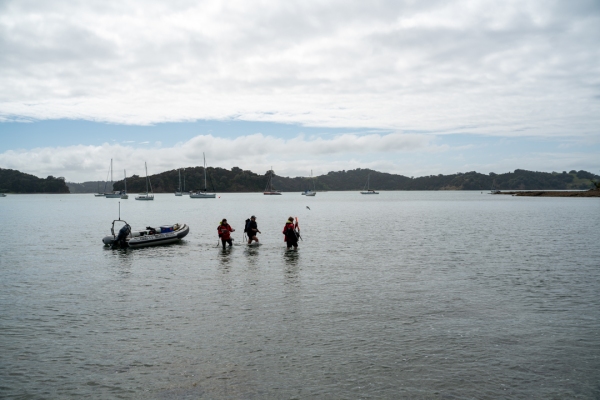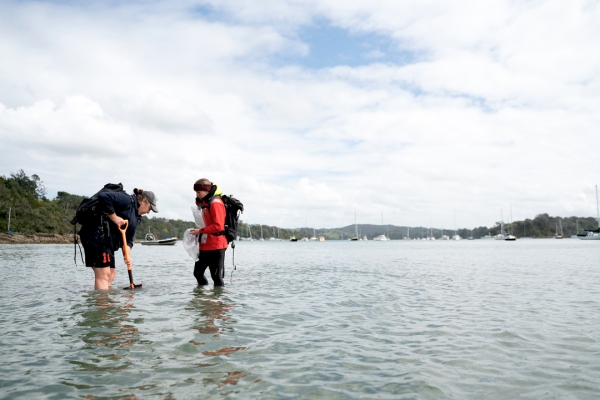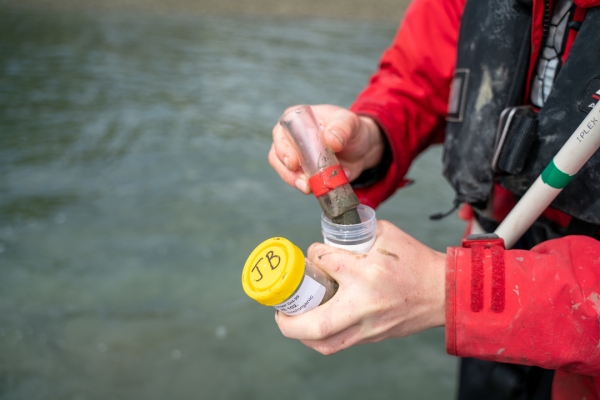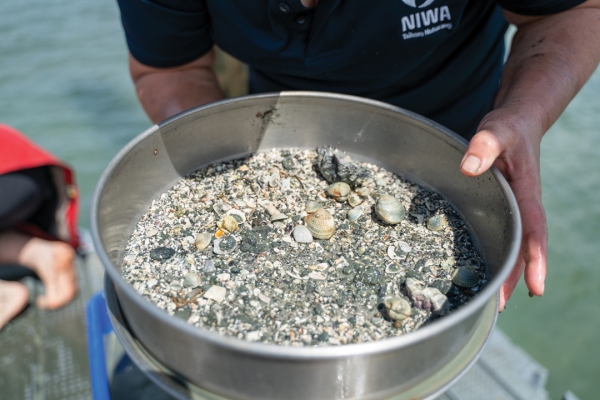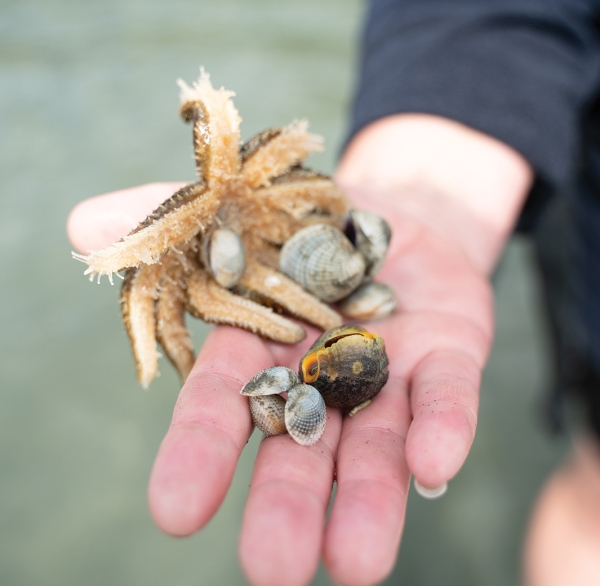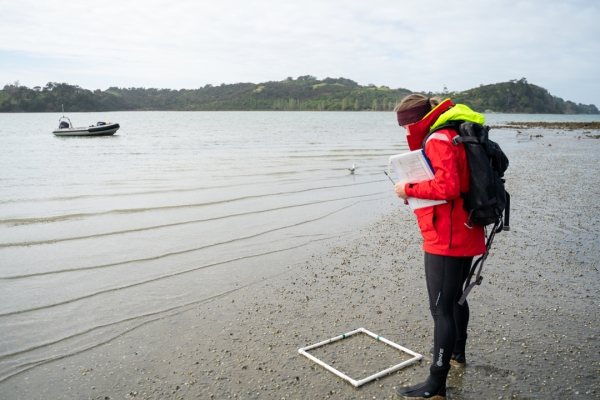On a cloudy October morning, three people wade through the shallows of the Mahurangi Estuary, just north of Auckland.
They’re up to their knees, sporting wetsuit booties and carting backpacks. Between them they carry a shovel, clipboards and a piece of PVC pipe. A small inflatable boat is anchored nearby.
NIWA researchers Kelly Carter and Sarah Hailes, and Auckland Council environmental specialist Martin Meyer are gathering samples to understand the long-term health of the Mahurangi Estuary.
They know – almost better than anyone – that like most of the country’s estuaries, this one is far from pristine.
The biggest challenge for our estuaries can be summed up in one word: mud.
“We’ve gone from sandy estuaries to these muddy systems,” says Dr Andrew Swales from his Hamilton office.
Swales, who leads NIWA’s Catchments to Estuaries programme, is a scientist who studies human impacts on estuaries.
He says the largest decline in Aotearoa New Zealand’s estuaries began in the mid-1800s when large tracts of land were deforested for farms and settlements.
“Unlike many countries where the human impacts have happened over many centuries, for us, some of the biggest impacts have happened in the last 170 years or so.”
When trees are removed from the land, soils become loose and are easily eroded. Heavy rain transports that soil into rivers.
Swales says that while steep land, frequent rain events, earthquakes and geology make New Zealand particularly susceptible to erosion, land clearance is the primary driver of the huge amounts of soil entering waterways.
The Ministry for the Environment and Statistics NZ estimate that New Zealand loses about 190 million tonnes of soil each year.
Like tar choking the lungs of a smoker, the sediment travels down waterways and settles in estuaries as mud.
Mud smothers bottom-dwelling animals. It makes the water cloudy and changes the landscape, ultimately impacting the estuarine habitats and the organisms that live in them.
Swales points to the Firth of Thames in Waikato as a classic example of a New Zealand estuary badly suffering from sedimentation.
“There was a sand flat in the southern Firth that is now buried under two metres of mud. Millions of tonnes of mud has accumulated over that sand flat in the last 50 years.
“People don’t realise how places have changed. I was talking to a retired farmer a few years ago. He told me that in the 1950s he used to go land-yachting on the sand flats in the southern Firth.”
Where a land-yacht might have once sailed across a firm, sand-bottomed Firth of Thames, the wheels would now sink into sticky muck, between mangroves.
Sedimentation isn’t the only challenge our estuaries are facing. Swales says that estuaries also trap a huge range of contaminants that enter rivers from human activities.
Urban contaminants include heavy metals such as zinc and copper, while farming contaminants are mostly pesticides and fertilisers such as nitrogen and phosphates.
From algal blooms to long-lasting chemical cocktails, the effects can be devastating.
There are more than 400 estuaries across the country. As transitional zones where freshwater flows into and mixes with saltwater, estuaries are unique environments.
They’re a place where people live, gather food and play. They are a nursery for our fisheries, protect low-lying coastal lands from storms and provide a home for hundreds of endemic species.
Swales says estuaries have too long played second fiddle to more visible features such as beaches and rivers. Considering their environmental importance, they don’t get the profile they deserve, he says.
As a child growing up on the North Shore, he remembers visiting the Barry’s Point Road rubbish dump. The tip wasn’t a hole in the ground. It was an estuary. People would just pull up to the water’s edge and throw their rubbish into the mangroves.
Swales says there has been an historic lack of integrated estuary management at a national scale.
“What activities are being undertaken in catchments? What are the impacts on the estuary? Estuaries have been forgotten. They fall through the gap between freshwater and the sea.
“Many people just don’t appreciate what we’ve lost and what we continue to lose.”
Back on the Mahurangi, the researchers are sampling their first site. It is part science, part resistance training.
They follow a small laminated map with random sample locations. The corer, a simple piece of PVC pipe, is pushed into the mud and lifted out with a spade.
The sediment sample is transferred into a bag which is tied shut and dropped into one of the researchers’ backpacks.
They will repeat this process 12 times at each site. All up, there are five sample locations dotted around the estuary – sites that have been visited four times each year since 1997 and which together tell the story of the Mahurangi estuary.
Kelly Carter says that the mud gets harder and harder to walk through as the sampling goes on.
“Our backpacks can weigh between 25 and 30kg with the samples. As soon as you have the cores in your backpack it feels like you can’t unstick yourself. Your calves really start to burn.”
Back at the boat, they organise the samples into storage bins for detailed analysis back in the lab.
Carter says the negative effects of sediment have been increasingly detected in the Mahurangi Estuary since monitoring began.
“It is interesting – coming so frequently for such a long time, you can actually start seeing the trends and notice quickly when things start changing. Currently, the data shows upward trends in five species that are known to increase with mud.”
However, compared with many estuaries, Carter says overall, the Mahurangi is in “moderate health”.
She points to tiny shellfish barely visible under the water.
“You can tell that this site is still healthy because cockles are still here. If your estuary lost all of its cockles, that would be a bad sign.”
Every sediment sample is meticulously sieved, to identify what is living in the estuarine sediments, and organisms such as cockles are exactly what researchers are looking for.
Dr Drew Lohrer is a marine ecologist who specialises in estuarine invertebrate communities and how they function.
He says invertebrates like worms, crabs and shellfish can provide many of the answers to changes in estuaries.
“We’ve developed indices of estuarine health that are based on the composition of these invertebrate communities. For example, if all the species that are sensitive to mud are disappearing, we might have a strong indication that too much fine sediment is being added to the estuary.
“In a single core of sediment you can get 30 to 40 species and up to 300 individuals."
“It requires a lot of understanding of these species, but when you know a little about their sensitivities and how they respond to these different types of stressors, you can get good information on what’s happening in the environment and what’s driving it.”
He says the invertebrates that live in estuarine sediments are perfect for this research: they’re long-lived and they don’t move around too much.
As well as studying the invertebrates, researchers also analyse the samples to assess what kinds of sediments and contaminants are entering the estuary.
Lohrer says, together, these methods give researchers a clear understanding of what is changing.
NIWA has worked closely alongside the Auckland Council for more than three decades to monitor estuaries in the region.
Lohrer says that the collaborative nature of the partnership has been key to research success and, ultimately, better estuary management.
“If they trust in the science and can incorporate it into policy that protects the marine environment, for a variety of users and uses, that’s the most beneficial thing."
“That, to me, is real success.”
After a productive morning on the Mahurangi Estuary, the researchers take a quick look at some of their samples before heading out to the remaining sites.
If carrying the backpacks through the mud was resistance training for the legs, the sieving is a full-on workout for the arms.
After a minute of vigorous shaking, the sediment clears through the mesh, leaving an array of crabs, worms and shellfish.
The researchers funnel the invertebrates into labelled containers filled with an alcohol solution that preserves the samples for laboratory analysis.
Hailes and Carter work like clockwork. It’s almost intuitive for them.
With an encyclopaedia-like knowledge of the invertebrates, they marvel at the tiny specimens emerging from the sediment, firing off both their common and scientific names.
Hailes holds up a carnivorous worm that wriggles across her hand.
“Aglaophamus macroura. It’s a predator, a polychaete worm. It eats smaller worms. They throw out their jaws, grab the prey and then suck it back in. It’s really cool.”
There are more than 100 species of worms that live in the Mahurangi Estuary. Hailes’ on-the-spot identification of the tiny worm belies the detailed work ahead carefully analysing their haul.
“There are 60 samples from this one trip, so that’s a week and a half of sorting and a week of IDs. It will take more than two weeks of processing.”
The Parliamentary Commissioner for the Environment, Simon Upton, recently released a 200-page report titled ‘Managing our Estuaries.’
It makes two main recommendations. The first is a management approach that treats estuaries and the waterways that feed into them as a single entity.
Lohrer agrees.
“We need to have an integrated plan to manage estuaries that starts up in the hilltops and runs out through to the coast. You can’t really manage estuaries if you can’t control what’s coming into them from up above."
“Estuaries are potentially one of the most sensitive parts of the freshwater to marine continuum, so until we manage for the most sensitive part of the system, we could be making mistakes.”
Estuaries exist in a zone that is managed by a confusing cluster of authorities and organisations, working under a mishmash of overlapping plans, legislation and policy statements.
One infographic in the Commissioner’s report attempts to visualise the maze of legislation and entities that needs to be considered when managing a single estuary. It is chaotic.
Upton describes it as “the sort of intimidating image that defies a summary,” and calls for a concise estuaries management framework to cut through the “complicated jigsaw.”
The second recommendation made by the report is for more, improved and nationally consistent monitoring.
Lohrer unequivocally agrees.
“Without monitoring, you have no idea about why things are changing, and you have difficulty disentangling what is natural variability from what is being driven by human-caused stressors.”
“I think that’s the most important thing about monitoring. You need to monitor over time to understand the natural variability, including things that are happening on greater than annual cycles.”
Lohrer says that his team’s methods have proven successful over decades and could be used throughout the country to gain insights into how estuaries are being impacted in different regions and why.
Birdsong echoes across the estuary as the field team climb back into their boat, heading out again to collect more samples.
For Hailes and Carter, the work always feels fresh. They say the incredible variety of life in estuaries brings something new every visit.
“I love it because it looks like nothing, but in Whangarei Harbour we collected 120-odd species in just one sample site. It’s just so diverse,” says Hailes.
“Estuaries are such vulnerable areas, and I don’t think they really get enough press. People don’t really understand how important they are.”
Photos by Sam Fraser-Baxter, NIWA
This story forms part of Water and Atmosphere - February 2021, read more stories from the series.

